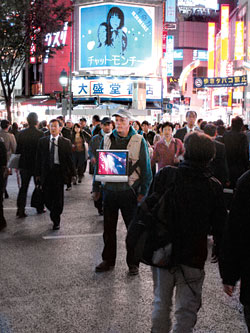I fell completely in love with this film. I’m a sucker for any kind of abstract film, especially when it has as a complex and hypnotizing score as Koyaanisqatsi does. Something, in particular, that struck me about this film was how much it explicitly states without saying a word. It makes it completely clear, through camera angles/effects and music, that what humans are doing to their environment is wrong, destructive, and will lead to an inevitable doom. This is not an thesis with which I am unfamiliar, but it usually is presented in the form of shocking statistics and dramatic pleas of those who have already been affected by our “koyaanisqatsi”, if you will.
The parallels it drew between clouds & water and machines & humans were beautifully done visually and musically. I was entranced by all of the shots and transitions from visual to visual. The natural shots were incredible, sensual, dramatic, and complex. They weren’t the usual nature scene. The beginning natural shots displayed life in clouds which was nicely juxtaposed to the life-less clouds that were later shown coming out of smoke stacks and explosions. The pervasive irony of cacophony during the first sped up highway scene and then complete silence when cut to a city scene forces the viewer to reevaluate every learned association that they’ve had with cities. The movie does that in many other ways, as well. By using the same musical theme in the scenes with the commercial airplane and the fighter jet, we’re forced to reconcile the obvious destruction that fighter planes cause with the atmospheric destruction in which everyone participates when they travel via air. It put things side by side that we normally wouldn’t see in that fashion and ties cinematographic and musical threads through those things so that we are faced with direct comparisons that show us uncomfortable truths.
The thesis of this film, which I mentioned briefly above, is that we are living in an unbalanced life and, if we continue in this fashion, the beautiful natural scenes and lively clouds in the beginning will recede into machine-like life which, sped up, will display routine, boring patterns as opposed to the organic, unique patterns of the natural world. The lively beauty of natural clouds will descend into depressingly deliberate dark, poisonous clouds that are only an externality, rather than a phenomenon to be appreciated intrinsically. This argument is made through the artistic juxtaposition of things that we wouldn’t naturally put side by side and the emotional music placed over things that we wouldn’t normally associate with the implied emotion. The film uses musical and cinematographic techniques such as discordant notes, odd-time signatures, heavy bass, unsettling speed, sped-up and slowed-down visuals, and unusual camera angles to place emotions upon common visuals and make us reevaluate our associations with these visuals. This reevaluation causes us to understand how the meaning of the Hopi proverbs relates to our current path of consumption, routine, and destruction.
As for the question, “can art help us save the world?”, my answer is of course. I don’t think we can save the world without it. People are trained from an early age on how to face a verbal argument that challenges their beliefs. They are less equipped with how to handle truth that is presented more abstractly. Then, when they do “get it”, it tends to hit them in a much more emotional way. Emotions, in my opinion, can sometimes be much more strong than reason.



